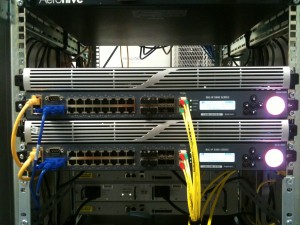This is an iRule for F5 BIGIP to balance on the requested http path, so http://domain.com/appversion1-0 or http://domain.com/appversion2-0 . The benefit is that you have different server pools under the same domain.
With the iRule you can also access every member and open a status.txt or servername.txt with the following path http://domain.com/monitor/servername.txt?app=appversion1-0&node=1 . This option is for monitoring reasons as you can monitor every node over the external URL.
I also use the status.txt for an http monitor to see if the server is online or offline. You can use that to set the web server offline without doing that over the F5 management console.
GET /monitor/status.txt HTTP/1.1\r\nHOST:\r\nConnection: Close\r\n\r\n Enable: ONLINE Disable: OFFLINE
In the servername.txt I write the name of the server.
This is the iRule:
when HTTP_REQUEST {
switch -glob [string tolower [HTTP::path]] {
"*appversion1-0*" { pool pool_http80_domain.com-appversion1-0}
"*appversion2-0*" { pool pool_http80_domain.com-appversion2-0}
"*monitor*" {
switch [URI::query [HTTP::uri] "app"] {
appversion1-0 {
switch [URI::query [HTTP::uri] "node"] {
1 { pool pool_http80_domain.com-appversion1-0 member 10.0.1.1 80 }
2 { pool pool_http80_domain.com-appversion1-0 member 10.0.1.2 80 }
default { HTTP::respond 200 content "<html><head><title>Member Status</title></head><body>INVALID OR MISSING QUERYSTRING: You must enter the URL in the following format http://domain.com/monitor/(status|servername).txt?app=AppVersionNumber&node=NodeNumber" "Content-Type" "text/html" }
}
}
appversion2-0 {
switch [URI::query [HTTP::uri] "node"] {
1 { pool pool_http80_domain.com-appversion2-0 member 10.0.2.1 80 }
2 { pool pool_http80_domain.com-appversion2-0 member 10.0.2.2 80 }
default { HTTP::respond 200 content "<html><head><title>Member Status</title></head><body>INVALID OR MISSING QUERYSTRING: You must enter the URL in the following format http://domain.com/monitor/(status|serversame).txt?app=AppVersionNumber&node=NodeNumber" "Content-Type" "text/html" }
}
}
default { HTTP::respond 200 content "<html><head><title>Member Status</title></head><body>INVALID OR MISSING QUERYSTRING: You must enter the URL in the following format http://domain.com/monitor/(status|servername).txt?app=AppVersionNumber&node=NodeNumber" "Content-Type" "text/html" }
}
}
default { pool pool_http80_domain-appversion1-0 }
}
}
The default app pool is appversion1-0 so everything that didn’t match is forwarded to that pool.
